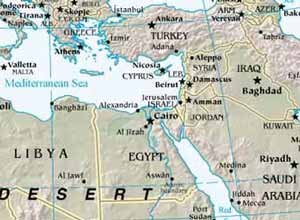
 The
Sea People
The
Sea PeopleIn the 13th and 12th centuries BC, a series of major crop failures in the northern and eastern Mediterranean appear to have triggered migrations through Anatolia and the Levant. These agricultural problems evidently led the Egyptian 19th Dynasty ruler Merenptah to send grain to the famine-stricken Hittites (who's civilization was in decline), and many Mycenaean urban centres appear to have been destroyed at this date. Among the new migrants in the Mediterranean region at this date were a loose confederation of ethnic groups from the Aegean and Asia Minor, known to the Egyptians as Sea Peoples. Some of these groups, such as the Denen, Lukka, and Sherden, were already active by the reign of Akhenaten (c.1352-1336 BC) [Amenhotep IV], while members of the Lukka, Sherden, and Pele set are portrayed as mercenaries fighting for the army of Ramesses II (c.1279-1213 BC) during the Battle of Kadesh.
 Later in the Ramesside Period, the Sea Peoples are
described and depicted on reliefs at Medinet Habu and Karnak as well as the
Great Harris Papyrus, a list of temple endowments in the reign of Rameses III
(1184-1153 BC). The latter sources indicate that the Sea Peoples were not simply
engaged in random acts of plundering but were part of a significant movement of
displaced peoples migrating into Syria-Palestine and Egypt. It is clear that
they planned to settle in the areas that they attacked, since they are portrayed
not merely as armies of warriors but also as whole families bringing their
possessions with them in ox-drawn carts. Study of the 'tribal' names recorded by
the Egyptians and Hittites has shown that various groups of the Sea Peoples can
be linked either with particular homelands, or at least with the places in which
they finally settled. Thus, the Ekwesh and Denen may possibly be correlated with
the Achaean and Danaean Greeks of the Iliad, the Lukka may have derived from the
Lycian region of Anatolia, the Sherden may have originated in Sardinia, and the
Peleset are almost certainly to be identified with the biblical Philistines (who
gave their name to Palestine).
Later in the Ramesside Period, the Sea Peoples are
described and depicted on reliefs at Medinet Habu and Karnak as well as the
Great Harris Papyrus, a list of temple endowments in the reign of Rameses III
(1184-1153 BC). The latter sources indicate that the Sea Peoples were not simply
engaged in random acts of plundering but were part of a significant movement of
displaced peoples migrating into Syria-Palestine and Egypt. It is clear that
they planned to settle in the areas that they attacked, since they are portrayed
not merely as armies of warriors but also as whole families bringing their
possessions with them in ox-drawn carts. Study of the 'tribal' names recorded by
the Egyptians and Hittites has shown that various groups of the Sea Peoples can
be linked either with particular homelands, or at least with the places in which
they finally settled. Thus, the Ekwesh and Denen may possibly be correlated with
the Achaean and Danaean Greeks of the Iliad, the Lukka may have derived from the
Lycian region of Anatolia, the Sherden may have originated in Sardinia, and the
Peleset are almost certainly to be identified with the biblical Philistines (who
gave their name to Palestine).
 The Sea People's first attack on the Egyptian Delta, in
alliance with the Libyans, dates to the fifth year of the reign of Merenptah
(c.1213-1203 BC). The individual groups of Sea Peoples (in addition to the Libyan
Meshwesh) are named as the Ekwesh, Lukka, Shekelesh, Sherden, and Teresh.
According to Merenptah's reliefs on one of the walls of the temple of Amun at
Karnak and the text of a stele from his funerary temple (the so-called Israel
Stela), he successfully repelled them, killing 6,000 and routing the rest. Moshe
Dothan's excavations at the Philistine city of Ashdod in 1962-1969 uncovered a
burnt layer dating to the 13th century BC, which may perhaps correspond
either to the Levantine campaign of the pharaoh Merenptah or the arrival of the
Peleset themselves.
The Sea People's first attack on the Egyptian Delta, in
alliance with the Libyans, dates to the fifth year of the reign of Merenptah
(c.1213-1203 BC). The individual groups of Sea Peoples (in addition to the Libyan
Meshwesh) are named as the Ekwesh, Lukka, Shekelesh, Sherden, and Teresh.
According to Merenptah's reliefs on one of the walls of the temple of Amun at
Karnak and the text of a stele from his funerary temple (the so-called Israel
Stela), he successfully repelled them, killing 6,000 and routing the rest. Moshe
Dothan's excavations at the Philistine city of Ashdod in 1962-1969 uncovered a
burnt layer dating to the 13th century BC, which may perhaps correspond
either to the Levantine campaign of the pharaoh Merenptah or the arrival of the
Peleset themselves.
From an Egyptian point of view, the final confrontation
with the Sea Peoples took place in the eighth year of Ramesses III's reign, by
which time they had probably captured the Syrian cities of Ugarit and Alalakh.
They attacked Egypt by both land and sea, the latter confrontation being
depicted in the celebrated sea-battle reliefs on the external walls of Ramesses III's
mortuary temple at Medinet Habu. This victory protected Egypt from overt
invasion from the north, but ultimately it was to be the more insidious
infiltration of Libyan peoples from the west that was more successful as a means
of gaining control of Egypt.
Medinet Habu
Karnak
Sources:
Ian Shaw, The Oxford History of Ancient Egypt